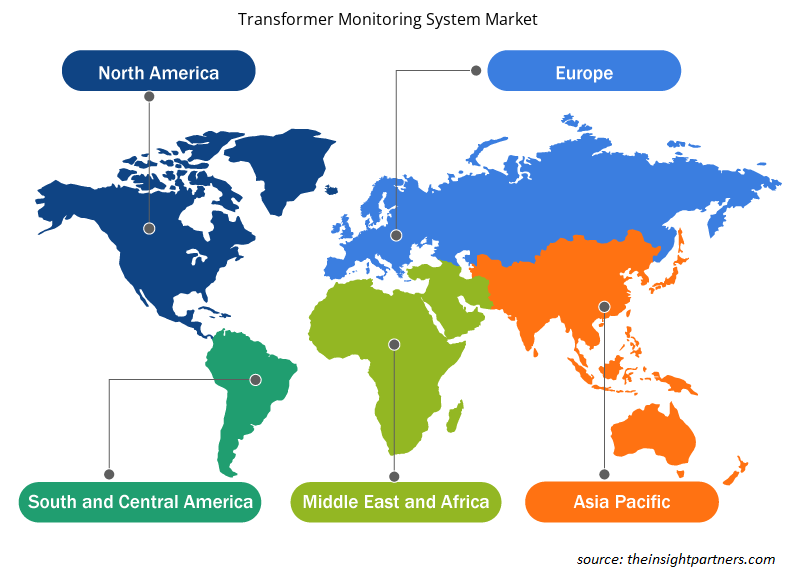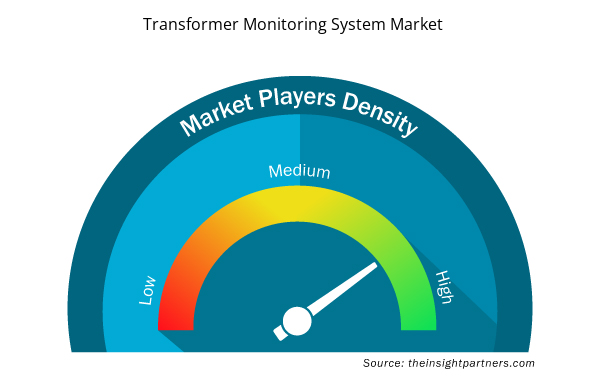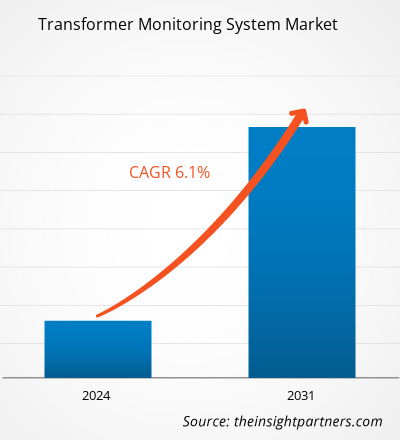Der Markt für Transformatorüberwachungssysteme soll von 2,21 Milliarden US-Dollar im Jahr 2023 auf 3,54 Milliarden US-Dollar im Jahr 2031 anwachsen. Der Markt wird voraussichtlich zwischen 2023 und 2031 eine durchschnittliche jährliche Wachstumsrate (CAGR) von 6,1 % verzeichnen. Die steigenden Investitionen in umweltfreundliche und energieeffiziente Elektrowerkzeuge dürften ein wichtiger Markttrend für Transformatorüberwachungssysteme bleiben.
Marktanalyse für Transformatorüberwachungssysteme
Der Markt für Transformatorüberwachungssysteme wächst rasant, da die zunehmende Digitalisierung in Versorgungsunternehmen den Einsatz von Leistungstransformatoren fördert und die weltweite Nachfrage nach sauberer und erneuerbarer Energieerzeugung steigt. Der Markt wächst stetig, angetrieben von der zunehmenden Sorge um Anlagenverwaltung und Betriebseffizienz. Darüber hinaus bieten die wachsende Nachfrage und Einführung von Big-Data-Analysetechnologie sowie zunehmende Investitionen in Offshore-Windparks lukrative Möglichkeiten für Marktwachstum.
Marktübersicht für Transformatorüberwachungssysteme
Ein Transformatorüberwachungssystem ist eine Reihe von Werkzeugen und Technologien, die gemeinsam zum Sammeln und Analysieren von Daten zu den Arbeitsbedingungen und der Leistung von Transformatoren verwendet werden. Das System wird verwendet, um den Status, die Qualität und die Leistung von Transformatoren zu bestimmen und deren Ausfälle vorherzusagen, Frühwarnungen bereitzustellen und Benutzern die Implementierung proaktiver Wartungs- und Austauschstrategien zu ermöglichen. Das Transformatorüberwachungssystem sammelt Daten zu zahlreichen Parametern, darunter Laststufenschalter, Kühlsystem , gelöstes Gas, Teilentladung, Durchführungsleistungsfaktor, Temperaturen, Druck und Ölstand im Transformator. Der Markt wird durch den wachsenden Energieverbrauch, die Digitalisierung von Fabriken und die steigende Nachfrage nach Transformatorüberwachungssystemen in der Energie- und Stromerzeugungsbranche angetrieben.
Passen Sie diesen Bericht Ihren Anforderungen an
Sie erhalten kostenlos individuelle Anpassungen an jedem Bericht, einschließlich Teilen dieses Berichts oder einer Analyse auf Länderebene, eines Excel-Datenpakets sowie tolle Angebote und Rabatte für Start-ups und Universitäten.
- Holen Sie sich die wichtigsten Markttrends aus diesem Bericht.Dieses KOSTENLOSE Beispiel umfasst eine Datenanalyse von Markttrends bis hin zu Schätzungen und Prognosen.
Treiber und Chancen auf dem Markt für Transformatorüberwachungssysteme
Die zunehmende Digitalisierung in der Energieversorgung fördert den Einsatz von Leistungstransformatoren und treibt den Markt an
Energieversorger investieren massiv in Prozessautomatisierung und digitale Überwachung und Verwaltung von Prozessen. Energieversorger benötigen eine große Anzahl von Sensoren und Datenverarbeitungstools, um die erfassten Daten intelligent zu verarbeiten und zu nutzen. Der Ausbau der Stromnetze zur Deckung des wachsenden Energiebedarfs gewerblicher, industrieller und privater Kunden erhöht den Bedarf der Energieversorger an Transformatoren für die ordnungsgemäße Stromverteilung. Energieversorger investieren auch in die Modernisierung der Netze, um deren Zuverlässigkeit und Belastbarkeit zu erhöhen. Dies erhöht die Nachfrage nach Transformatorüberwachungssystemen zum Austausch veralteter Transformatoren und zur Modernisierung der veralteten Infrastruktur. Transformatorüberwachungssysteme spielen eine wichtige Rolle bei der Überwachung von Netzwerken für Übertragungs- und Verteilungsunternehmen auf Erzeugungsebene. Die Überwachung von Erzeugungstransformatoren ist entscheidend, bevor Strom ins Netz eingespeist wird. Dies verpflichtet Energieversorger, ihr Überwachungssystem für eine effiziente Stromverteilung zu digitalisieren. Daher wird erwartet, dass die Digitalisierung der Versorgungsunternehmen die Nachfrage nach Transformatorüberwachungssystemen erhöhen wird.digitalize their monitoring system for efficient distribution of electricity. Thus, the digitization of utilities is expected to increase demand for transformer monitoring systems.
Zunehmende Nutzung von Big Data Analytics-Technologie – eine Chance auf dem Markt für Transformatorüberwachungssysteme
Big Data Analytics erhöht die Nachfrage nach Leistungstransformatoren in der Energiebranche. Big Data Analytics ermöglicht es Versorgungsunternehmen, ihre Stromversorgungssysteme zu optimieren, indem sie riesige Mengen Echtzeitdaten über die Nachfrage und das Angebot von Elektrizität sammeln und analysieren. Diese datengesteuerte Methode ermöglicht einen effizienteren Netzbetrieb und verbessert die Gesamtsystemleistung. Der steigende Energiebedarf der Verbraucher ermutigt die Energiebranche, moderne Leistungstransformatoren einzusetzen, die sich an wechselnde Lasten anpassen und problemlos mit Datenanalysesystemen kommunizieren können. Darüber hinaus schaffen die erheblichen Vorteile, die Big Data Analytics-Technologie für Transformatorüberwachungssysteme bietet, darunter unter anderem vorausschauende Wartung, Erkennung von Problemen und Fehlern sowie Überprüfung von Daten, Chancen auf dem Markt.
Segmentierungsanalyse des Marktberichts zum Transformatorüberwachungssystem
Wichtige Segmente, die zur Ableitung der Marktanalyse für Transformatorüberwachungssysteme beigetragen haben, sind Komponente, Service und Anwendung.
- Basierend auf den Komponenten ist der Markt für Transformatorüberwachungssysteme in Hardware- und IT-Lösungen unterteilt. Das Hardwaresegment hatte im Jahr 2023 einen größeren Marktanteil.
- In Bezug auf den Service ist der Markt für Transformatorüberwachungssysteme in Durchführungsüberwachung, Öl-/Gasüberwachung und andere unterteilt. Das Segment Durchführungsüberwachung hatte im Jahr 2023 einen größeren Marktanteil.
- Auf der Grundlage der Anwendung ist der Markt in Verteilungstransformatoren, Leistungstransformatoren und andere segmentiert. Das Segment der Leistungstransformatoren hielt im Jahr 2023 den größten Marktanteil.
Marktanteilsanalyse für Transformatorüberwachungssysteme nach Geografie
Der geografische Umfang des Marktberichts zum Transformatorüberwachungssystem ist hauptsächlich in fünf Regionen unterteilt: Nordamerika, Asien-Pazifik, Europa, Naher Osten und Afrika sowie Südamerika/Süd- und Mittelamerika.
Aufgrund der zunehmenden Industrialisierung und der raschen Urbanisierung wird der Markt im asiatisch-pazifischen Raum im Prognosezeitraum voraussichtlich stark wachsen. Der technologische Fortschritt und die wachsende Zahl von Projekten im Bereich erneuerbarer Energien schaffen Chancen für den Markt in der Region. Transformatorüberwachungssysteme sind bei Projekten im Bereich erneuerbarer Energien äußerst nützlich, um Probleme zu erkennen und zu vermeiden, die zu kostspieligen Ausfällen führen könnten.
Regionale Einblicke in den Markt für Transformatorüberwachungssysteme
Die regionalen Trends und Faktoren, die den Markt für Transformatorüberwachungssysteme während des gesamten Prognosezeitraums beeinflussen, wurden von den Analysten von Insight Partners ausführlich erläutert. In diesem Abschnitt werden auch die Marktsegmente und die Geografie von Transformatorüberwachungssystemen in Nordamerika, Europa, im asiatisch-pazifischen Raum, im Nahen Osten und Afrika sowie in Süd- und Mittelamerika erörtert.

- Erhalten Sie regionale Daten zum Markt für Transformatorüberwachungssysteme
Umfang des Marktberichts zum Transformatorüberwachungssystem
| Berichtsattribut | Details |
|---|---|
| Marktgröße im Jahr 2023 | 2,21 Milliarden US-Dollar |
| Marktgröße bis 2031 | 3,54 Milliarden US-Dollar |
| Globale CAGR (2023 - 2031) | 6,1 % |
| Historische Daten | 2021-2022 |
| Prognosezeitraum | 2024–2031 |
| Abgedeckte Segmente | Nach Komponente
|
| Abgedeckte Regionen und Länder | Nordamerika
|
| Marktführer und wichtige Unternehmensprofile |
|
Dichte der Marktteilnehmer für Transformatorüberwachungssysteme: Die Auswirkungen auf die Geschäftsdynamik verstehen
Der Markt für Transformatorüberwachungssysteme wächst rasant, angetrieben durch die steigende Nachfrage der Endnutzer aufgrund von Faktoren wie sich entwickelnden Verbraucherpräferenzen, technologischen Fortschritten und einem größeren Bewusstsein für die Vorteile des Produkts. Mit steigender Nachfrage erweitern Unternehmen ihr Angebot, entwickeln Innovationen, um die Bedürfnisse der Verbraucher zu erfüllen, und nutzen neue Trends, was das Marktwachstum weiter ankurbelt.
Die Marktteilnehmerdichte bezieht sich auf die Verteilung der Firmen oder Unternehmen, die in einem bestimmten Markt oder einer bestimmten Branche tätig sind. Sie gibt an, wie viele Wettbewerber (Marktteilnehmer) in einem bestimmten Marktraum im Verhältnis zu seiner Größe oder seinem gesamten Marktwert präsent sind.
Die wichtigsten auf dem Markt für Transformatorüberwachungssysteme tätigen Unternehmen sind:
- ABB Ltd.
- Eaton Corporation plc
- Honeywell International Inc.
- Schneider Electric SE
- Siemens AG
- Schweitzer Engineering Laboratories, Inc.
Haftungsausschluss : Die oben aufgeführten Unternehmen sind nicht in einer bestimmten Reihenfolge aufgeführt.

- Überblick über die wichtigsten Akteure auf dem Markt für Transformatorüberwachungssysteme
Neuigkeiten und aktuelle Entwicklungen zum Markt für Transformatorüberwachungssysteme
Der Markt für Transformatorüberwachungssysteme wird durch die Erfassung qualitativer und quantitativer Daten nach Primär- und Sekundärforschung bewertet, die wichtige Unternehmensveröffentlichungen, Verbandsdaten und Datenbanken umfasst. Im Folgenden finden Sie eine Liste der Entwicklungen auf dem Markt für Transformatorüberwachungssysteme und -strategien:
- Im Oktober 2023 investierte Eaton Corporation plc 85 Millionen US-Dollar, um die nordamerikanische Produktion wichtiger Versorgungslösungen zu steigern und so die Energiewende und Elektrifizierung voranzutreiben. Die Investitionen in die regionale Fertigung erhöhen die Versorgung mit Transformatoren, Reglern, Schaltanlagen und anderen Versorgungsgeräten. (Quelle: Eaton Corporation plc, Pressemitteilung, 2023)
Marktbericht zu Transformatorüberwachungssystemen – Umfang und Ergebnisse
Der Bericht „Marktgröße und Prognose für Transformatorüberwachungssysteme (2021–2031)“ bietet eine detaillierte Analyse des Marktes, die die folgenden Bereiche abdeckt:
- Marktgröße und Prognose auf globaler, regionaler und Länderebene für alle wichtigen Marktsegmente, die im Rahmen des Projekts abgedeckt sind
- Marktdynamik wie Treiber, Beschränkungen und wichtige Chancen
- Wichtige Zukunftstrends
- Detaillierte PEST/Porters Five Forces- und SWOT-Analyse
- Globale und regionale Marktanalyse mit wichtigen Markttrends, wichtigen Akteuren, Vorschriften und aktuellen Marktentwicklungen
- Branchenlandschaft und Wettbewerbsanalyse, einschließlich Marktkonzentration, Heatmap-Analyse, prominenten Akteuren und aktuellen Entwicklungen
- Detaillierte Firmenprofile
- Historische Analyse (2 Jahre), Basisjahr, Prognose (7 Jahre) mit CAGR
- PEST- und SWOT-Analyse
- Marktgröße Wert/Volumen – Global, Regional, Land
- Branche und Wettbewerbsumfeld
- Excel-Datensatz



Report Coverage
Revenue forecast, Company Analysis, Industry landscape, Growth factors, and Trends

Segment Covered
This text is related
to segments covered.

Regional Scope
North America, Europe, Asia Pacific, Middle East & Africa, South & Central America

Country Scope
This text is related
to country scope.
Häufig gestellte Fragen
The incremental growth expected to be recorded for the global transformer monitoring system market during the forecast period is US$ 1.33 billion.
The global transformer monitoring system market is expected to reach US$ 3.54 billion by 2031.
The key players holding majority shares in the global transformer monitoring system market are ABB Ltd., Eaton Corporation plc, Honeywell International Inc., Schneider Electric SE, and Siemens AG.
The growing investment in eco-friendly and energy-efficient power tools is anticipated to play a significant role in the global transformer monitoring system market in the coming years.
The growing digitalization in utilities encourages the use of power transformers and increasing global demand for clean and renewable energy generation are the major factors that propel the global transformer monitoring system market.
The global transformer monitoring system market was estimated to be US$ 2.21 billion in 2023 and is expected to grow at a CAGR of 6.1% during the forecast period 2023 - 2031.
Trends and growth analysis reports related to Technology, Media and Telecommunications : READ MORE..
The Insight Partners performs research in 4 major stages: Data Collection & Secondary Research, Primary Research, Data Analysis and Data Triangulation & Final Review.
- Data Collection and Secondary Research:
As a market research and consulting firm operating from a decade, we have published and advised several client across the globe. First step for any study will start with an assessment of currently available data and insights from existing reports. Further, historical and current market information is collected from Investor Presentations, Annual Reports, SEC Filings, etc., and other information related to company’s performance and market positioning are gathered from Paid Databases (Factiva, Hoovers, and Reuters) and various other publications available in public domain.
Several associations trade associates, technical forums, institutes, societies and organization are accessed to gain technical as well as market related insights through their publications such as research papers, blogs and press releases related to the studies are referred to get cues about the market. Further, white papers, journals, magazines, and other news articles published in last 3 years are scrutinized and analyzed to understand the current market trends.
- Primary Research:
The primarily interview analysis comprise of data obtained from industry participants interview and answers to survey questions gathered by in-house primary team.
For primary research, interviews are conducted with industry experts/CEOs/Marketing Managers/VPs/Subject Matter Experts from both demand and supply side to get a 360-degree view of the market. The primary team conducts several interviews based on the complexity of the markets to understand the various market trends and dynamics which makes research more credible and precise.
A typical research interview fulfils the following functions:
- Provides first-hand information on the market size, market trends, growth trends, competitive landscape, and outlook
- Validates and strengthens in-house secondary research findings
- Develops the analysis team’s expertise and market understanding
Primary research involves email interactions and telephone interviews for each market, category, segment, and sub-segment across geographies. The participants who typically take part in such a process include, but are not limited to:
- Industry participants: VPs, business development managers, market intelligence managers and national sales managers
- Outside experts: Valuation experts, research analysts and key opinion leaders specializing in the electronics and semiconductor industry.
Below is the breakup of our primary respondents by company, designation, and region:

Once we receive the confirmation from primary research sources or primary respondents, we finalize the base year market estimation and forecast the data as per the macroeconomic and microeconomic factors assessed during data collection.
- Data Analysis:
Once data is validated through both secondary as well as primary respondents, we finalize the market estimations by hypothesis formulation and factor analysis at regional and country level.
- Macro-Economic Factor Analysis:
We analyse macroeconomic indicators such the gross domestic product (GDP), increase in the demand for goods and services across industries, technological advancement, regional economic growth, governmental policies, the influence of COVID-19, PEST analysis, and other aspects. This analysis aids in setting benchmarks for various nations/regions and approximating market splits. Additionally, the general trend of the aforementioned components aid in determining the market's development possibilities.
- Country Level Data:
Various factors that are especially aligned to the country are taken into account to determine the market size for a certain area and country, including the presence of vendors, such as headquarters and offices, the country's GDP, demand patterns, and industry growth. To comprehend the market dynamics for the nation, a number of growth variables, inhibitors, application areas, and current market trends are researched. The aforementioned elements aid in determining the country's overall market's growth potential.
- Company Profile:
The “Table of Contents” is formulated by listing and analyzing more than 25 - 30 companies operating in the market ecosystem across geographies. However, we profile only 10 companies as a standard practice in our syndicate reports. These 10 companies comprise leading, emerging, and regional players. Nonetheless, our analysis is not restricted to the 10 listed companies, we also analyze other companies present in the market to develop a holistic view and understand the prevailing trends. The “Company Profiles” section in the report covers key facts, business description, products & services, financial information, SWOT analysis, and key developments. The financial information presented is extracted from the annual reports and official documents of the publicly listed companies. Upon collecting the information for the sections of respective companies, we verify them via various primary sources and then compile the data in respective company profiles. The company level information helps us in deriving the base number as well as in forecasting the market size.
- Developing Base Number:
Aggregation of sales statistics (2020-2022) and macro-economic factor, and other secondary and primary research insights are utilized to arrive at base number and related market shares for 2022. The data gaps are identified in this step and relevant market data is analyzed, collected from paid primary interviews or databases. On finalizing the base year market size, forecasts are developed on the basis of macro-economic, industry and market growth factors and company level analysis.
- Data Triangulation and Final Review:
The market findings and base year market size calculations are validated from supply as well as demand side. Demand side validations are based on macro-economic factor analysis and benchmarks for respective regions and countries. In case of supply side validations, revenues of major companies are estimated (in case not available) based on industry benchmark, approximate number of employees, product portfolio, and primary interviews revenues are gathered. Further revenue from target product/service segment is assessed to avoid overshooting of market statistics. In case of heavy deviations between supply and demand side values, all thes steps are repeated to achieve synchronization.
We follow an iterative model, wherein we share our research findings with Subject Matter Experts (SME’s) and Key Opinion Leaders (KOLs) until consensus view of the market is not formulated – this model negates any drastic deviation in the opinions of experts. Only validated and universally acceptable research findings are quoted in our reports.
We have important check points that we use to validate our research findings – which we call – data triangulation, where we validate the information, we generate from secondary sources with primary interviews and then we re-validate with our internal data bases and Subject matter experts. This comprehensive model enables us to deliver high quality, reliable data in shortest possible time.


 Holen Sie sich ein kostenloses Muster für diesen Bericht
Holen Sie sich ein kostenloses Muster für diesen Bericht